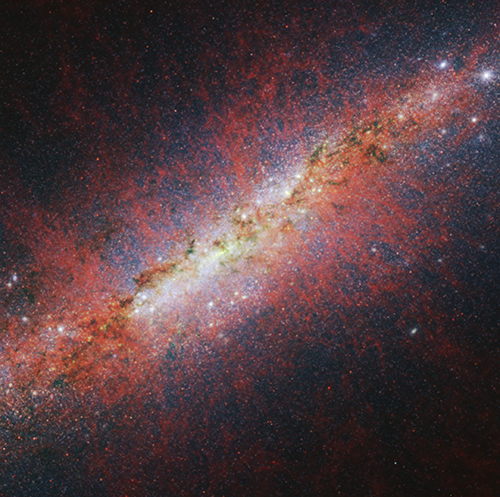A University of Toledo astronomer is part of an international team unveiling new insights into Messier 82 (M82), a nearby extreme star-forming galaxy that’s sprouting new stars 10 times faster than the Milky Way.
“Our research is significant because it’s the first detailed view of the dusty interstellar material within a starburst as it gets ‘launched’ out of its host galaxy at high speed,” said Dr. J.D. Smith, a professor in the Department of Physics and Astronomy and director of the Ritter Astrophysical Research Center. “Outflows like these play an incredibly important role in the lives of most galaxies, including the Milky Way, and to have access to such a remarkable nearby example as M82 at the James Webb Space Telescope’s exquisite resolution is giving us key insights into this process.”

A NASA-provided photo of Messier 82 (M82), an extreme star-forming galaxy that’s sprouting new stars 10 times faster than the Milky Way.
Alberto Bolatto, of the University of Maryland, College Park, led the team that directed Webb’s near-infrared camera instrument toward the center of M82. This was during the first cycle of scheduled observing time on the space telescope, which launched in December 2021. The team’s observations offer a closer look at the physical conditions that foster the formation of new stars, with one area of focus in the galactic wind rushing out of the core of the starburst.
Many galactic winds are caused by the rapid rate of star formation and subsequent supernovae. By resolving a central section of M82, the astronomers were able to examine where the wind originates and gain insight on how hot and cold components interact within the wind.
Using Webb’s NIRCam instrument, they also were able to trace the surprisingly fine structure of this wind via emission from sooty chemical molecules known as polycyclic aromatic hydrocarbons (PAHs), and to uncover a similar structure between the PAH emission and that of hot, ionized gas.
“It was unexpected to see the PAH emission resemble ionized gas,” Bolatto said. “PAHs are not supposed to live very long when exposed to such a strong radiation field, so perhaps they are being replenished all the time. It challenges our theories and shows us that further investigation is required.”
The team’s findings have been accepted for publication in The Astrophysical Journal.
The research is accompanied by visually stunning images of the galaxy, with PAH emission appearing as red filaments tracing the shape of galactic wind. Smith said he and other astronomers on the team continue to work with spectroscopic data from M82, gathered with a different instrument on Webb, whose analysis will be released with additional large-scale images of the galaxy.